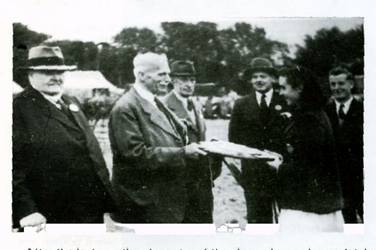
Wayland Show 1948A "Quack Doctor" would usually start his practice by dispatching a boy from the audience to pur chase a long list of medical items from the local chemist shop and on return the boy received "tup pence" for the errand. Next, the doctor would ask the audience if they suffered from any complaint and having been told one, would mix up a concoction and hand it in a bottle, if in liquid form, or if in ointment form, in a small pillbox and charge from I/- to 2/6, depending on the cost of the ingredients used. He would carry on making up the "wonderful secret mixture" as long as he could find a customer. A typical example of a "Smart Alec" was the man with a suit case containing about 100 wage packets, each with a small priceless article inside. After a few rallying calls and a bit of banter to attract a large crowd he would start his business by informing the audience that each package contain ed a small, but useful gift. Then he would place a pocket watch in about twenty packets and a golden sovereign in five or six more and mix them in with those already filled in the case. Picking out one of the bulkier looking packets he would ask who would give him a shilling for it. Usually one of the first three customers found a watch in the packet, but the next twenty or so received useless articles. Then, as no more customers were forthcoming, he would place another sovereign in a packet and offer it to some one for 2/6, but by sleight of hand the packet, when opened, only contained another useless gift. In the early 1920's the High Street, from Thetford road to the brewery, would be packed solid with people by 11 a.m. until 6 p.m., when they would wind their way to the fair on Mr. Sample's meadow. A few years later there were other fairs on both Hall & Palmer's and Burnham’s sale meadows and also a circus on what is now Lime Tree Walk. On wet days the fair grounds were soon inches deep in mud and dozens of people lost a boot or shoe in the gluey squelch. Undeterred they continued tram ping from coconut and skittle stands, to boxing booths and rock stalls, remarking that they might as well get wet outside as in, having previously spent much of the day in one, or another, of the dozen inns in the town at that time.
After the last war the character of the show changed completely with exceptionally large entries in both the horse jumping and goat classes. Dog competitions were also introduced and out went the fodder crops of mangles, sweeds and turnips, while rabbits, poultry, sheep and pigs were also missing from many a "show day", but each year saw more and more commercial stands, many of which had no connection with agriculture. The last forty years have seen vast social changes and with most families possessing a car, thus enabling them to find their entertainment further afield, fodder crops and the like wouldn't attract a single visitor to-day. The show organisers must find it more and more difficult to provide crowd- pulling entertainment each year and I am sure they would welcome any new ideas in this field, as without the income received from commercial stands etc., it would probably be impossible to make sufficient money to continue running the Wayland Show. |

